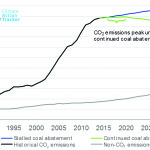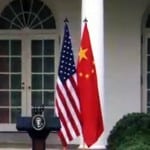Reaching an unexpected climate breakthrough, the U.S. and China in a joint statement on Wednesday each announced new targets to slash carbon dioxide emissions by 2030.
President Barack Obama set a new target to cut U.S. carbon emissions between 26% and 28% below 2005 levels by 2025. Chinese leader Xi Jinping, meanwhile, said his country is committing to peak its carbon dioxide emissions around 2030, and that it would also boost its share of non-fossil fuel energy to around 20% by 2030.
The new U.S. target compares to the administration’s 2009 commitment to reduce emissions by 17% below 2005 levels by 2020. The Environmental Protection Agency’s (EPA’s) June-proposed Clean Power Plan, meanwhile, seeks to slash carbon emissions from existing U.S. power plants by 30% from 2005 levels by 2030.
China, which is grappling with severe air pollution and has stepped up measures to control it, is expected to add 448 GW of new coal capacity over the next decade to meet soaring forecasts for electricity demand. The country’s pronounced signals in recent years to address carbon pollution include the establishment of seven regional cap-and-trade plans, and a possible nationwide cap-and-trade plan.
At the September United Nations climate summit in New York City, Vice Premier Zhang Gaoli also said the country would adopt a climate change plan to reduce the country’s carbon dioxide emission intensity (CO2 emissions per unit of gross domestic product) between 40% and 45% by 2020, compared with the 2005 level.
China is already making significant headway with the installation of non-fossil generation capacity. The country’s non-fossil power share hovered at about 10% at the end of 2013, and the newly announced 20% target compares with a 15% goal announced at the September summit. Between 2004 and 2013, China installed 307 GW of new renewable capacity, while about 40% of the world’s nuclear reactors currently under construction are in China.
Early reactions to the announcement included criticism by Republican leaders. Senate minority leader Mitch McConnell (R-Ky.)—who is likely to replace Sen. Harry Reid (R-Nev.) as majority leader following Republican electoral gains in the midterm elections—said the new targets were “unrealistic,” and that the U.S. economy could not sustain the “President’s ideological War on Coal.”
A number of global entities lauded the announcement from the world’s top two carbon dioxide emitters as a “jolt” of political momentum that would spur transformative action ahead of the COP 21, the December 2015 summit in Paris where the UN hopes all countries will agree to a plan under the United Nations Framework Convention on Climate Change (UNFCCC) to cut their greenhouse gas (GHG) emissions enough to stay within the 2-degree-Celsius target. The first draft of that agreement is hoped to be concluded by December 2014 at a summit in Lima, Peru.
Some observers, however, commented that the commitments weren’t enough. “Make no mistake, more needs to be done,” said the World Resources Institute’s Climate Program Director Jennifer Morgan. “The U.S. and China should strive to achieve the upper range of their commitments and go even further in the future. They can raise the bar to take full advantage of the economic opportunities of a low-carbon future.”
—Sonal Patel, associate editor (@POWERmagazine, @sonalcpatel)










